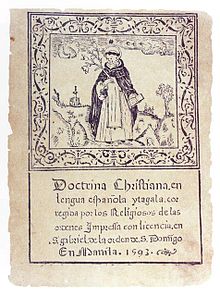- Doctrina Christiana
-
Doctrina Christiana was written by Fray Juan de Plasencia, and is believed to be one of the earliest books printed in the Philippines, in the year 1593.[1]
The Doctrina Christiana is remarkable not only for having been printed at such an early age in a elaborated Gothic font of the Spanish language, but also for having copies made in Tagalog versions, both in Latin script and the commonly used Baybayin script of the natives at the time, plus another translation made in traditional Chinese language.
There is some controversy about which of the versions is the first book of the Spanish Philippines, with some scholars believing that the Chinese language version titled Doctrina Christiana en letra y lengua China (Wuchi t’ien-chu cheng-chiao chen-chuan shih-lu) was printed in 1590 to 1592 by the Chinese printer Keng Yong in Manila before the Spanish and Tagalog versions.
One of the earliest references to both versions come from Gómez Pérez Dasmariñas, the seventh governor-general of the Philippines, who wrote a letter to Philip II of Spain on June 20, 1593, that read:
“ “Sire, in the name of Your Majesty, I have for this once, because of the existing great need, granted a license for the printing of the Doctrinas Christianas, herewith enclosed—one in the Tagalog language, which is the native and best of these islands, and the other in Chinese—from which I hope great benefits will result in the conversion and instruction of the peoples of both nations; and because the lands of the Indies are on a larger scale in everything and things more expensive, I have set the price of them at four reales a piece, until Your Majesty is pleased to decree in full what is to be done.”[2]
” Contents
Contents of the book
The book consists of thirty-eight leaves and seventy-four pages of text in Spanish, Tagalog transliterated into roman letters, and Tagalog in Tagalog characters, under a woodcut of St. Dominic, with the verso originally blank, although in contemporary versions bears the manuscript inscription, "Tassada en dos reales", signed Juan de Cuellar.
Literally translated from Spanish as “Christian Doctrine” the primary goal of the book was to propagate the Christian teachings across the Philippines archipelago. Common Catholic vocal prayers were all included in the book. After a syllabary comes the Pater Noster, followed by the Ave Maria, Credo, Salve Regina, Articles of Faith, Ten Commandments, Commandments of the Holy Church, Sacraments of the Holy Church, Seven Mortal Sins, Fourteen Works of Charity, Confession and Catechism.
Missionary fathers placed the Doctrina among the books necessary to have in print in foreign lands. As such, the Filipino book is similar to the one printed in Mexico in 1539 in Spanish and local Mexican vernacular, followed by St. Francis Xavier’s "Doutrina Christão" in Malay language printed by the Jesuit press at Goa, in India, in 1557. Another Doctrina was printed in Spanish and the native languages at Lima in 1584.
Physical characteristics
The book was printed on paper made from the paper mulberry.[3] The size of the volume, which is unbound, is 9⅛ by 7 inches, although individual leaves vary somewhat due to chipping. Some of the leaves have become separated from their complements, but enough remain in the original stitching to indicate that the book was originally made up in four gatherings, the first of twelve leaves, the second of ten, the third of ten, and the fourth of six. Although the book is of the size called quarto, the method of printing must have been page by page, so it is doubtful that each sheet was folded twice in the usual quarto manner, but more probable that it was printed four pages to a sheet of paper approximately 9⅛ by 14 inches, which was folded once.
The volume was printed using the xylographic technique, printing each page of text from one hand-carved wood block. Vertical lines long the inner margins of some pages were made by the inked edge of the block, and the grain of the wood appears as striations throughout the printed areas.
Printed copies in existence
Apart from the copy that may be found at the Library of Congress in Washington, DC, there aren't any other known copies in existence today. Both the quality of the paper, passing of time, natural agents and destructive events, such as earthquakes and fires all contributed to the disappearance of most printed copies. The only known existing copies of early Philippine books are those that were sent to Europe during the 16th, 17th, and 18th centuries—so there may be additional copies uncatalogued in some library.
Such was the case for the copy sent to the King of Spain Philip II by the Governor of the Philippines in 1593. This is believed to be the same copy that reappeared in 1946 in the possession of a Paris bookseller and collector who specialized in Pacific imprints. William H. Schab, a New York dealer, purchased the book from him and took it to the United States, where he resold it to Lessing J. Rosenwald, who in turn presented it to the Library of Congress, where it remains. The only known surviving copy of the Chinese version is at the Biblioteca Nacional in Madrid.
See also
References
- ^ Lessing J. Rosenwald. "Lessing J. Rosenwald Collection". Library of Congress. World Digital Library. http://hdl.loc.gov/loc.wdl/wdl.82. Retrieved 2010-11-28.
- ^ Retana, Wenceslao (1894). La Politica de España en Filipinas, No. 97. Manila.
- ^ Pardo De Tavera, Trinidad (1893). Noticias sobre La Imprenta y el Grabado en Filipinas. Madrid. pp. 9–10.
External links
- Full text of Doctrina Christiana at Project Gutenberg
- Doctrina Christiana: The First Book Printed in the Philippines available at Filipiniana.net
Categories:- Philippine literature
- Spanish-language literature
- Tagalog language
- 1593 books
- Chinese-language books
Wikimedia Foundation. 2010.

